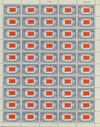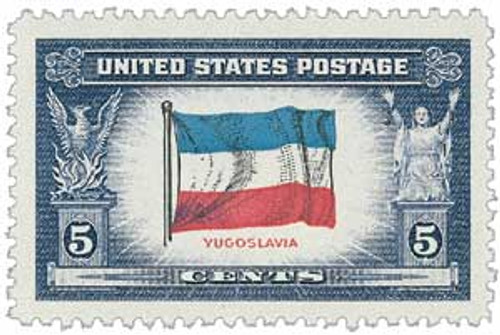
1943 Overrun Countries: 5c Flag of Albania
# 918 - 1943 Overrun Countries: 5c Flag of Albania
$0.60 - $35.00
U.S. #918
5¢ Flag of Albania
Overrun Countries Series
5¢ Flag of Albania
Overrun Countries Series
Issue Date: November 9, 1943
City: Washington, D.C.
Quantity: 14,999,646
Printed by: American Bank Note Company
Printing Method: Flat-Plate
Perforations: 12
Color: Blue violet, dark red, and black
City: Washington, D.C.
Quantity: 14,999,646
Printed by: American Bank Note Company
Printing Method: Flat-Plate
Perforations: 12
Color: Blue violet, dark red, and black
U.S. #918 is part of the Overrun Countries Series, which honors each of the nations invaded by Axis powers during World War II. It pictures the flag of Albania, which features a red background with a black two-headed eagle at its center. It is based on the seal of Gjergj Skanderberg, who led the 15th century revolt against the Ottoman Empire, bringing some regions of Albania a period of independence. The flag was officially adopted in 1922.
Albania and World War II
On April 7, 1939, Italy invaded Albania with Benito Mussolini declaring Italy’s King Victor Emmanuel III as king. This made Albania one of the first nations to be occupied by Axis powers in World War II. Mussolini saw the occupation of Albania as part of his dream to create a Roman Empire. The following year, Mussolini used the Albanian base to attack Greece, but was defeated, leading to Greek occupation in Southern Albania.
In 1942, the Albanian National Liberation Front was formed, composed of nationalist and communist groups. The Albanians successfully battled the Italians, but in September 1943, German paratroopers began occupying the Albanian capitol of Tirana. Albania was liberated on November 28, 1944, one of the last nations to remove the Germans from their country.
These Stamps Brought Hope to Overrun Countries of WW II
After receiving several designs from artists who felt the current U.S. postage stamps were unattractive, President Franklin Roosevelt began to consider the types of stamps he wanted to issue. He sought to show the world that America was in this war to achieve world peace, not military dominance. With this in mind, the President suggested the U.S. issue a series of stamps picturing the flags of all the overrun nations in Europe.
In the border surrounding each flag, Roosevelt suggested picturing the Phoenix – an ancient symbol of rebirth. He believed “It might tell those suffering victims in Europe that we are struggling for their own regeneration.” The other side of each flag pictured a kneeling woman “breaking the shackles of oppression.”
When the time came to print the stamps, the Bureau of Engraving and Printing was unable to print the multiple colors needed for each flag, so the American Bank Note Company received a special contract for this series.
Additionally, a 5¢ denomination – the foreign rate for first class postage – was chosen so the stamps could be used on overseas mail. The stamps were printed in relatively small quantities and were in high demand as soon as they were issued, with stocks across the country running out almost as soon as they were released.
FDR – The Stamp-Collecting President
President Franklin Roosevelt was instrumental in the design and issuance of U.S. #918. Franklin Delano Roosevelt’s mother introduced the future President to stamp collecting at a young age. Throughout his life, he turned to his collection to relax and unwind.
Roosevelt was elected President four times, serving in the nation’s highest office longer than any other chief executive – 12 years. During those 12 years, Roosevelt promoted the importance of stamps by personally approving each of more than 200 stamp designs. This included suggesting topics, rejecting others, and even designing some of the stamps himself. He used U.S. postage stamps to educate Americans about their heritage, to buoy war-weary spirits during World War II, and to send a message of peace and hope as Europe faced the overwhelming task of rebuilding.
U.S. #918
5¢ Flag of Albania
Overrun Countries Series
5¢ Flag of Albania
Overrun Countries Series
Issue Date: November 9, 1943
City: Washington, D.C.
Quantity: 14,999,646
Printed by: American Bank Note Company
Printing Method: Flat-Plate
Perforations: 12
Color: Blue violet, dark red, and black
City: Washington, D.C.
Quantity: 14,999,646
Printed by: American Bank Note Company
Printing Method: Flat-Plate
Perforations: 12
Color: Blue violet, dark red, and black
U.S. #918 is part of the Overrun Countries Series, which honors each of the nations invaded by Axis powers during World War II. It pictures the flag of Albania, which features a red background with a black two-headed eagle at its center. It is based on the seal of Gjergj Skanderberg, who led the 15th century revolt against the Ottoman Empire, bringing some regions of Albania a period of independence. The flag was officially adopted in 1922.
Albania and World War II
On April 7, 1939, Italy invaded Albania with Benito Mussolini declaring Italy’s King Victor Emmanuel III as king. This made Albania one of the first nations to be occupied by Axis powers in World War II. Mussolini saw the occupation of Albania as part of his dream to create a Roman Empire. The following year, Mussolini used the Albanian base to attack Greece, but was defeated, leading to Greek occupation in Southern Albania.
In 1942, the Albanian National Liberation Front was formed, composed of nationalist and communist groups. The Albanians successfully battled the Italians, but in September 1943, German paratroopers began occupying the Albanian capitol of Tirana. Albania was liberated on November 28, 1944, one of the last nations to remove the Germans from their country.
These Stamps Brought Hope to Overrun Countries of WW II
After receiving several designs from artists who felt the current U.S. postage stamps were unattractive, President Franklin Roosevelt began to consider the types of stamps he wanted to issue. He sought to show the world that America was in this war to achieve world peace, not military dominance. With this in mind, the President suggested the U.S. issue a series of stamps picturing the flags of all the overrun nations in Europe.
In the border surrounding each flag, Roosevelt suggested picturing the Phoenix – an ancient symbol of rebirth. He believed “It might tell those suffering victims in Europe that we are struggling for their own regeneration.” The other side of each flag pictured a kneeling woman “breaking the shackles of oppression.”
When the time came to print the stamps, the Bureau of Engraving and Printing was unable to print the multiple colors needed for each flag, so the American Bank Note Company received a special contract for this series.
Additionally, a 5¢ denomination – the foreign rate for first class postage – was chosen so the stamps could be used on overseas mail. The stamps were printed in relatively small quantities and were in high demand as soon as they were issued, with stocks across the country running out almost as soon as they were released.
FDR – The Stamp-Collecting President
President Franklin Roosevelt was instrumental in the design and issuance of U.S. #918. Franklin Delano Roosevelt’s mother introduced the future President to stamp collecting at a young age. Throughout his life, he turned to his collection to relax and unwind.
Roosevelt was elected President four times, serving in the nation’s highest office longer than any other chief executive – 12 years. During those 12 years, Roosevelt promoted the importance of stamps by personally approving each of more than 200 stamp designs. This included suggesting topics, rejecting others, and even designing some of the stamps himself. He used U.S. postage stamps to educate Americans about their heritage, to buoy war-weary spirits during World War II, and to send a message of peace and hope as Europe faced the overwhelming task of rebuilding.



















